Search Engine Optimisation (SEO) is one of the most common digital marketing practices. Search engines continue to play a major part in where users end up on the internet, and that won’t change any time soon. That’s why anyone who owns a website should aim to measure the success of their SEO efforts.
There are lots of SEO performance metrics out there, and as a result it can be quite confusing to determine your SEO performance. This guide will take you step-by-step through your SEO health check and how to improve your SEO game.
Usually, one would start this article by defining SEO, its importance, and best practices. However, this has been tackled before in lots of our previous articles that you can check out before reading on SEO performance metrics.
So, let’s get started on the topic of metrics.
Table of Contents
Why Do You Need to Measure Your SEO Performance Metrics?
Before explaining what SEO performance metrics are, you need to understand why you need them.
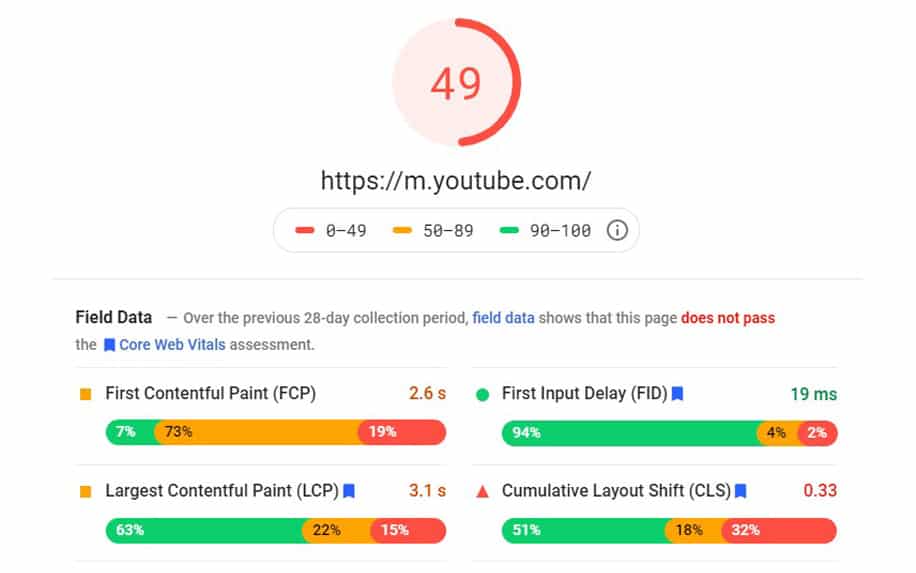
There are two scenarios where you need to measure your SEO performance metrics. You either want to set up a new SEO strategy, so you need to know where you stand. Or, you need to evaluate the success of an SEO campaign.
In order to work on improving your website’s SEO, you need to create a solid SEO strategy. Setting up an SEO strategy depends not only on your business objectives and goals but also on your current SEO performance. This is a long-term strategy that is not done overnight.
Therefore, your strategy when your website’s performance is 8/10 would be totally different than your strategy when your website is only 2/10, for example. Measuring your SEO performance metrics is like a medical check-up where you understand what the problems and pain points are and then set up a strategy to improve things.
Sometimes you as a business or even your client will want to measure the SEO efforts which have been carried out. They will want to ensure that their investment is worthwhile and has real returns.
In that case, the SEO specialist or the agency needs to justify their actions and prove to the client that their efforts have paid off with measurable statistics. Problems can start when the client doesn’t understand what these statistics represent.
Therefore, these numbers need to be clear as well as translatable into real profits.
Later in the article, you’ll find out how to present these numbers in a friendly and digestible manner.
Measuring SEO Performance Metrics Isn’t Easy
Because SEO has so many aspects, assessing your performance metrics is no easy task. There are several statistics and aspects you need to consider, as looking at only one aspect could be misleading. For example, your website’s traffic could be high, but if the bounce rate is also too high, there’s a problem.
You won’t have a full picture unless you analyse all the numbers together. However, once you establish your goals and the KPIs you would like to measure, you will find it easy to repeat your assessment every quarter and keep track of your SEO performance.
What Are SEO Performance Metrics?
Site owners today have access to a colossal amount of data about their online performance, and almost all of these data points can provide valuable insights. Indeed, you won’t have an issue with a lack of information, but rather narrowing the wealth of data available into a manageable number of metrics for your reports.
There are more than 200 different factors that contribute to your SEO performance. Therefore you must understand that no single metric is enough to measure the success of your SEO – you must look at the big picture. So, here are nine important SEO performance metrics that will help you focus on KPIs that matter.
Keyword Rankings
Keyword rankings are everyone’s favourite SEO performance metric. Keyword rankings refer to your web page’s positioning within search engine result pages (SERPs) for a particular keyword search query. Your rank is merely where you stand in the results page.
For example, Google, the most popular search engine, shows ten websites on every page. If you’re number one, it means Google suggests your website as the most relevant to the query.
Your ranking number is important. However, the keywords you rank for themselves will tell you a variety of things. First, it’ll show you whether or not you’re targeting the right keywords. If your site is nowhere to be found for your target keywords, then you need to change your strategy towards less competitive keywords, at least temporarily.
Secondly, they’ll give you a glimpse of whether or not your site is actually growing. In time, you should see your rankings improve, as well as the total number of keywords your site is ranking for.
It’s good to note that for starting websites, ranking number doesn’t matter. What truly matters is seeing an increase in how many keywords you’re ranking for. When you start to rank for more keywords, then this means you’re picking up long-tail traffic.
Backlinks Quality and Quantity
What is backlinking? Put simply, backlinks are one of the top factors that affect your SEO performance. A backlink is simply a link from one website to another. Search engines like Google use backlinks as a ranking signal; because when one website links to another, it means they believe the content has value.
The quality of your backlinks is another way to learn more about who refers to your website.
Not all websites have the same authority. For example, governmental and educational websites will have more authority than the website of a small café. Websites aren’t all equal on the authority scale; it differs according to traffic, how old the website is and many other factors. It’s important to understand that both the quality and quantity of backlinks are significant.
On the other hand, there is also organic backlinking and ‘promoted’ backlinking. Unlike organic link building, promoted linking is promoted or advertised by you. There are many strategies that website owners use to get more backlinks.
Among those are resource page link building, broken link building and the skyscraper technique. To be able to analyse this SEO performance metric you need to understand what these techniques refer to.
It also pays to look into a resource page link building strategy. Resource pages are pages that link out to awesome content on a given topic. Because these pages exist for the sole purpose of linking out, they make perfect link building targets. After finding relevant resource pages, you weigh their authority and see if your website would truly benefit from linking to it.
Of course, the content that they would link to needs to be relevant for them to agree to link to you in the first place. Finally, you start reaching out to these pages by asking them to link to your website. So, to mine for these resources pages, use these search strings in Google:
- “Keyword” + inurl:links
- “Keyword” + “helpful resources”
- “Keyword” + “useful resources”
- “Keyword” + “useful links
Then there’s a broken link building strategy. Many times, when bloggers write content and link to another webpage, the other webpage gets removed or breaks down. So, when a visitor clicks on a link and finds that it takes them nowhere, they can get quite frustrated.
Google recognises that frustration and scores websites down for it. That’s the beauty of broken link building strategy.
Broken link building is the practice of building backlinks by replacing links to 404 pages with a working link to a target website. In that case you’re trying to replace other broken backlinks with your content. So, when you reach out to bloggers or websites, you’re no longer begging for a referral.
You’re actually doing that blogger/website a favour, so they’re more likely to accept. All that you need to do is find websites and blogs relevant to your keywords. Start mining for broken backlinks on their pages. Then reach out to them in a friendly manner to have them replace old broken links with yours.
It goes without saying that your content should be of high quality.
Finally, there’s the Skyscraper Technique. The skyscraper technique is a three-step strategy that bloggers use to get more backlinks and social shares:
- It starts by finding the best content that already ranks in the very first page for relevant keywords.
- Next, create even better content.
- Finally, promote that content.
The skyscraper technique requires investing in producing brilliant content and investing in some efforts to actually promote that content after creating it. Later in the article, you’ll find out how to promote your content to improve your SEO performance. Watch this video if you’re interested to know more about the skyscraper technique.
Let’s get back to SEO performance metrics. Measuring your backlinking performance will clarify how effective your link building strategies are. For example, if you’re doing broken link building and you’re getting a good response rate on the emails you send out, this strategy is working out for you. If not, you should improve the way you reach out to bloggers.
Moreover, your backlinking performance guides you to potential sources for future link building. Chances are, not every link pointing towards your site is one that you’ve built yourself. By tracking your links, you’ll be able to identify potential opportunities for future links. Another important insight is figuring out how cost-effective your strategy is.
There has to be a rationality between what you spend to acquire a backlink and the influence it has on your website. If you spent $500 to acquire a single link, and that link didn’t budge your rankings, then it’s time to adjust your strategy towards cheaper link acquisition options.
Organic Traffic
It comes naturally to measure your SEO performance by the number of people who visit your website organically. Using Google Analytics, this is one of the easiest and simplest SEO performance metrics to measure.
Remember that the exact number of visitors doesn’t matter much. What truly matters is seeing a healthy growth rate. So, even a steady and slow growth rate is considered positive.
Since sometimes numbers can be deceiving, measuring the quality of your organic traffic makes your findings more accurate. To make sure that you’re not ‘click baiting’ your visitors into your website, you need to analyse your visitors’ behaviour during their visit.
Time Spent on Page
The visitors’ engagement with your website is a sign that the number of organic traffic you gained is real and positive. Google and other search engines interpret the duration a visitor spends on your website as their opinion of it. That’s why they consider it as one of the factors that affects your ranking.
Visitors staying for a longer time means they’re interested in the content you offer. The longer they stay, the better. Using Google Analytics, you can find out the average time spent on every post. This is a good way to categorise your content into the good, the bad and the ugly.
Although the longer, the better rule applies here. There is no time spent that is considered ideal. It all depends on the purpose of the post or the website. For example, it’s great if a visitor spends an average of five minutes on a blog post. However, it’s a very short time to be spent on a social media app.
Bounce Rate
Bounce rate is a metric that measures the percentage of people who land on your website and do completely nothing on the page they visited. They don’t click on a menu item, a ‘read more’ link or any other internal links on the page. This means that Google Analytics’ server doesn’t receive a trigger from the visitor.
A ‘bounce’ is identified based on five typical signs:
- Visitors click the browser back button
- Visitors enter a new URL in the address bar
- Visitors close the browser window or tab
- Visitors stay inactive for more than 30 minutes and the session times out
- Visitors click an outbound link
Indeed, bounce rate is a tricky SEO performance metric. Having a high bounce rate doesn’t necessarily mean that there’s something wrong. It could be that the quality of the page is low, or there’s nothing inviting to engage with. But it could also be that visitors simply found the information that they were looking for and left.
According to CustomMediaLabs, here are some benchmark bounce rate averages for the most common kinds of websites:
- 20% – 45% for e-commerce and retail websites
- 25% – 55% for B2B websites
- 30% – 55% for lead generation websites
- 35% – 60% for non-ecommerce content websites
- 60% – 90% for landing pages
- 65% – 90% for dictionaries, portals, blogs and generally websites that revolve around news and events
Once again, the purpose of the page becomes your way of interpreting bounce rates correctly. It’s always better to add a ‘read more’ button to your blogs in order to get a more accurate reading of your bounce rate.
Mobile Traffic
Mobile traffic is an important SEO performance metric to keep track of. It’s a fact that there are more mobile users than desktop users. Of course, that number of traffic matters. However, the real reason why measuring mobile traffic matters is that it is a sign of an optimised website.
A rise in mobile traffic means that you’re doing things right in the eyes of Google. It means that your site is responsive, loads quickly and has high engagement metrics. Without these in place, you simply wouldn’t rank in mobile search.
For some specific niches, mobile traffic is king. These niches include beauty & fitness; people & society, pets & animals and home & garden. So, if your website revolves around one of these themes, you have to make sure that your website is highly appealing to mobile users.
Domain Authority
Domain authority is calculated by evaluating multiple factors, including linking root domains and the number of total links into a single DA score. This score can then be used when comparing websites or tracking the ‘ranking strength’ of a website over time. Domain authority is not a metric used by Google in determining search rankings and has no effect on the SERPs.
Some particular industries have high domain authority scores such as:
- Media and Publishing: 86.23
- Higher Education: 78.67
- Sports and Entertainment: 75.55
- Accommodation and Food Services: 71.27
- Software and Applications: 67.52
There are two important terms that contribute to domain authority and they also give you some more understanding of the importance of the quality of backlinks. These two terms are trust flow and citation flow.
According to Majestic SEO, Trust Flow is a score between 0 and 100 based on a website’s quality. When creating this metric, Majestic manually scoured websites and created a secret list of trusted ‘seed sites.’ These ‘seed sites’ form the foundation for trust flow. The closer a website is linked to a seed site, the higher its trust flow score will be.
For example, Facebook has a near-perfect TF, meaning it’s likely a seed site. A backlink from Facebook would then benefit your TF score.


As sites are linked to each other, trust ‘flows’ through them. Below you can see that trust originates with Site A (a seed site). As Site A is linked to Site B and so forth, trust flows through the websites and each respective TF metric diminishes.
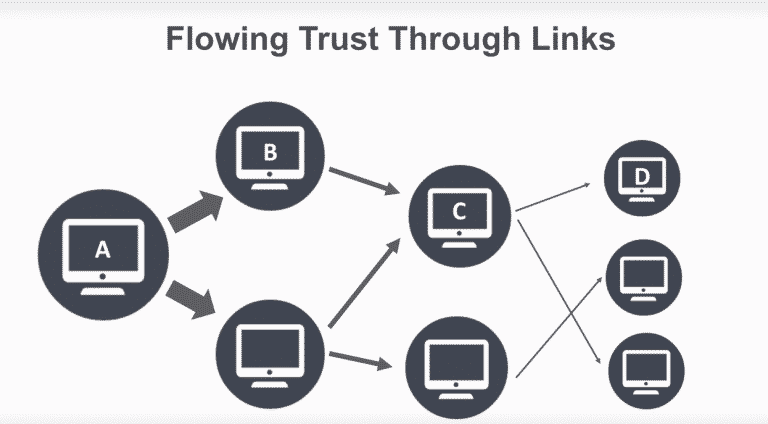
On the other hand, citation flow also measures the equity or power of a website or link; but based on the number of links coming to it. It’s also a score between 0-100 that gives you an idea of how influential a website is.
Returning Visitors and Direct Visitor
Although these metrics aren’t essential, they give you valuable insights into the quality of your site’s content. If you have many visitors returning, that’s a great sign. People can’t get enough of your website. They trust you and consider you a source where they can find their needs. You should consider re-evaluating your content if the proportion of returning visitors is less than 25%.
Page Loading Speed
Admit it: you’ve probably closed a tab or exited an application because it took a painfully long time to load.
No visitor wants that kind of frustration. That’s why your page loading speed is an SEO performance metric that matters. If you’re investing time and money in SEO and keyword rankings, don’t blow it by overlooking a slow loading website.
This may not be the place to discuss how to increase the loading speed of your website, but it’s good to mention how to identify the performance of your loading speed. To find out whether or not your website takes forever to load, head to Google PageSpeed Insights.
This is a tool from Google that analyses your website’s overall speed and gives it a score just by typing your URL. It will also tell you what’s causing the website speed to be low.

SEO Performance Metrics Tools
Google Analytics
Google Analytics is a marvellous and massive tool that enables you to measure many of these SEO performance metrics. That makes it your right-hand man whenever you’re analysing the performance of your SEO. Through Google Analytics, you can find out the number of your organic traffic, the time your visitors spend on the website as well as the bounce rate.
If there is one or more pieces of data you want to see at a glance every time you login to your analytics, be sure to set it up in the Dashboards area. You can create multiple dashboards, each of which can contain multiple widgets.
To create a new dashboard, simply go under Dashboards in the menu bar of your analytics and then select New Dashboard. Then add your widgets. You can choose from widgets that show you one particular metric, a pie chart comparing metrics, a timeline of one to two metrics, or a table showing a dimension with two specific metrics.
Once you’re on the home dashboard, click on the button labelled ‘Add Segment’ to keep track of the change in organic search traffic.
- Time Spent and Bounce Rate: On the left-hand side of your dashboard, if you click on ‘Behaviour’ then select ‘Overview’, you’ll be able to discover the overall time your visitors spend on your site. If you’d like to dig deeper to identify the time spent per post/page, click on ‘view full report’. This same screen will show you the average time spent per page and the bounce rate.
- Mobile Visitors: If you would like to take a look at the number of mobile visitors, go to your home dashboard once again, navigate to Audience > Mobile > Overview. This will bring up a screen that will show you what percentage of your traffic you get from mobile, and how your mobile site performance stacks up. Similarly, you can find out the number of returning visitors vs. new visitors by navigating to Audience > Overview.
- Page by Page Load Time Speed: To measure page load times on a page-by-page basis, navigate to Behaviour > Site Speed > Page Timings. Preferably, set the middle column to ‘Avg. Page Load Time’ and the right column to ‘% Exit’. You can also add a ‘Secondary Dimension’ of Medium, and filter down to show only organic traffic.
What this report shows you in the top most row is the average page load time site wide, and the average exit percentage (where a visitor decides to leave the site) on a page-by-page basis. It’s also fairly easy to see in this report that as your page load time surpasses your site wide average, exit percentages begin to skyrocket.
UberSuggest
UberSuggest is one of the tools that Neil Patel offers for free on his website. Through UberSuggest, you can find out the number of organic traffic, domain score, get a full report on backlinks and find out the keywords you rank for. All you should do is simply add the domain you want to analyse. It’s so easy you can do it in your sleep.
In addition, it also shows you relevant keywords that work for your website. So, in a way, it provides you with great content ideas. UberSuggest is seriously a gem. Moreover, you can create a dashboard by adding up to five different projects or websites that you can keep track of.
That makes UberSuggest a wonderful tool for analysing the SEO performance of your competitors or the highest-ranking websites in your niche as well. You can also sign up to receive notifications that will give you a weekly report of your SEO performance metrics including your ranking on Google.
Yoast
The third tool on the list is Yoast SEO Plugin. Many websites are running on WordPress. The coolest thing about Yoast is that it shows you on-page SEO performance metrics on the spot while creating your blog post. You don’t need to wait after publishing or extract an SEO performance report every quarter.
Yoast offers SEO performance metrics while you’re creating your pages or posts. That’ll empower you to optimise your code, your title tags, and your meta description. It will even help you create an XML sitemap that you can just plugin to Google Search Console for free. That way, when you release new content, it pings Google and lets him through the sitemap so that Google can index that content, grab it, and rank it.
Website Responsive Test
The reason you want to go to websiteresponsivetest.com is that your site needs to be more mobile compatible. Google has a mobile-first index. Mobile-first indexing means Google predominantly uses the mobile version of the content for indexing and ranking. Historically, the index primarily used the desktop version of a page’s content when evaluating the relevance of a page to a user’s query.
Since the majority of users now access Google Search with a mobile device, Googlebot primarily crawls and indexes pages with the smartphone agent going forward.
By putting your website’s URL on this tool, it’ll tell you if your website is responsive and mobile friendly. The more mobile friendly it is, the higher it will rank in Google’s mobile-first index. Remember that there are also different devices with different operating systems for mobile devices out there; Android and iOS mainly. Therefore, your website needs to be compatible with all.
This tool will ensure that you achieve that.
SEO Performance Metrics for Content
So, what if you want to analyse the quality of your content in terms of SEO? How appealing is your content to Google? Are there any SEO performance metrics for content? Yes, there sure is.
Starting with the basics, you should do a content audit once every six months. This involves going through your content and assessing every post’s quality against your SEO checklist.
What Should Your Content’s SEO Checklist Involve?
Start with keywords. Make sure that the keywords you’re using on your website are still relevant to your target audience. It’s crucial to keep your content fresh and updated. Visitors will immediately find out if your content seems outdated and you may break record of bounce rate.
Next, remember that visuals are a central SEO performance metric for content; especially if your blog post is long. You need to make it engaging by adding images, illustrations, and info-graphs.
Speaking of longer blog posts, another metric that you should invest in is the length of your content. Google and other search engines love deep and thorough content where visitors can really find valuable information. Therefore, consider involving a variety of brief and longer content on your website.
Moving to another important SEO performance metric for content which is featured snippets. Featured snippets are a format which is supposed to provide users with a concise, direct answer to their questions – right there on the search results page, without the users having to click through to a specific result.

To increase the likelihood of your content getting ‘snipped’ for a featured snippet, there are a few tactics you can try:
- Answer questions definitively in your content.
- Make your content the highest quality possible.
- Use numbered and bulleted lists.
- Include stats and data.
- Structure your content logically.
Snippets are the main driver for search engine users to click on your website. That’s why featured snippets have a powerful impact on driving clicks. Take some time to learn about attractive titles that drive more visitors.
Moreover, the formatting of your content should be clear, easy to read and inviting. Always make sure you have titles and subtitles. Put yourself in the reader’s place and give them a pleasurable read on your website.
SEO Hacks to Improve Your SEO Performance Metrics
So, let’s dwell on strategies and hacks that you can adopt in order to improve your SEO performance. Analysing your performance is a step to know where you currently stand. However, your ultimate goal is to achieve better results that translate into higher traffic, better ranking, longer time spent on page and lower bounce rates. Here are guaranteed strategies that would ensure improved SEO performance metrics.
Use Pillar Pages and Topic Clusters
The old way of doing things was that people used to write forty or fifty articles about the same topic over and over. Now, that doesn’t work anymore. When you have ten or fifty articles on the same topic, it sort of confuses Google. Which one should Google rank?
They’re all competing for the same keywords and they’re all linked to each other and they all have backlinks. Instead, you should use pillar pages and topic clusters. What do these terms refer to? Take a look at these two pictures. Would you rather shop in a grocery store that looks like the first picture or the second one?
Hands down, anyone would choose the second. Google would, too. A topic is a broad umbrella concept, while a keyword represents a component of that concept. It’s very similar to the way a grocery store groups relevant food items into aisles.
In the example above, ‘produce’, ‘meat’, and ‘dairy’ are the topics. Within each topic are a handful of subtopics (for example, ‘fruit’ and ‘vegetables’ are subtopics within the main topic of ‘produce’). Within the subtopics, ‘apples’ and ‘bananas’ are the keywords.
Similarly, a topic cluster is a collection of interlinked articles and website pages centred around one umbrella topic. Creating a topic cluster allows you to dive deeper into a core topic while creating an efficient site architecture in the process. But unlike a grocery store, a website doesn’t have physical aisles.
In order to organise the website’s structure, a topic cluster is built around a central ‘pillar’ page that links to more specialized articles within that topic.
For example, if you want to build authority around the topic ‘workout routines’, your cluster would look something like this:
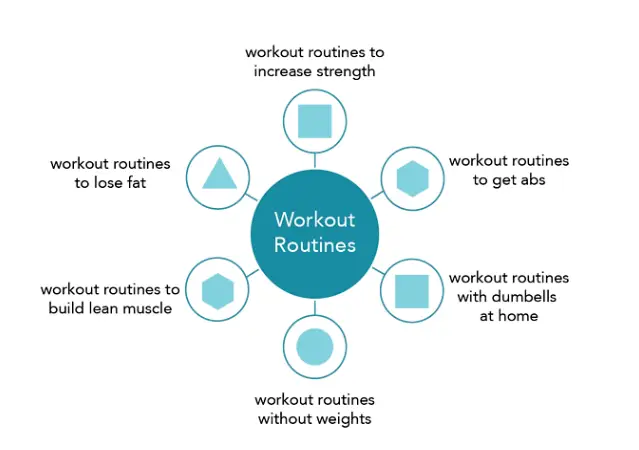
Update Your Old Content Regularly
What usually happens is that you write a good article, then you publish it and forget about it. You keep adding new ones in hope of following the latest trends in the industry and attracting new visitors. You think that the more articles you publish per month, the bigger your traffic will be. This ‘publish and forget’ model isn’t truly efficient.
You don’t need to increase the number of published articles as much as you need to capitalise on older articles by making them fresh.
If you published an article about SEO performance metrics back in 2016, it will naturally have a higher total number of visits than a brand new published article targeting the same keyword today. That’s why it’s always wise to build upon older articles by editing them and making them up to date.
Accordingly, you should spend the bigger portion of your time tweaking and updating older articles. If your publishing frequency is four to five articles per month, you need to be editing ninety articles per month. Of course, that all depends on the total number of articles you have. But you should invest a big chunk of time working on the SEO of articles published earlier as this is one of the best SEO hacks.
Land and Expand
No matter how good you are at SEO, no matter how much content you create, there’s no guarantee that an article will rank well. Naturally, some pieces of content will do really well; people will love them and Google will rank them. But some others will not do well regardless of your expectations.
One can call that the ‘natural selection of content’. The Land and Expand strategy means that you land the best performing articles or pieces of content and expand them to become even better.
So, if you find that one page is getting many views and visitors are engaging with it, go to Google Search Console. Find out which keywords drive traffic to this page.
Verify which of these keywords would make sense within the article’s context. Then, go back to your article and include any additional keywords that your article did not tackle. If the additional keywords make sense, your article will perform even better and better. However, do that only if the keywords are truly relevant. Don’t force or ‘stuff’ keywords because Google is watching!
That way, your best performing articles will be covering more ideas. They’ll become more deep and thorough, and therefore, give more value to users. That’ll increase your chances at ranking higher.
Conquer the World
If your business or website theme is a universal one, there’s great potential in translating your content into other languages. Most of Google users are non-English speakers and there’s much less competition in other regions. Therefore, considering other languages can bring a lot more visitors to your website. That’ll give your website more authority and will set you as an expert in what you’re providing.
Create a Tool on Your Website
Adding a tool on your site gets you tons of extra traffic. Many Internet users use Google because they want to get fast answers to their questions. That’s why the most viral and easiest traffic you will get is from the tool. There are several tools out there that you can choose from according to your industry.
UberSuggest, the tool mentioned earlier used for SEO performance analysis, is actually a free tool on Neil Patel’s website that drives the highest traffic.
There are wonderful, cool examples of calculators and tools that websites have created to gain traffic. Many health websites and pharmacies have a Body Mass Index calculator on their website. There’s even a dog feeding calculator, take a look!
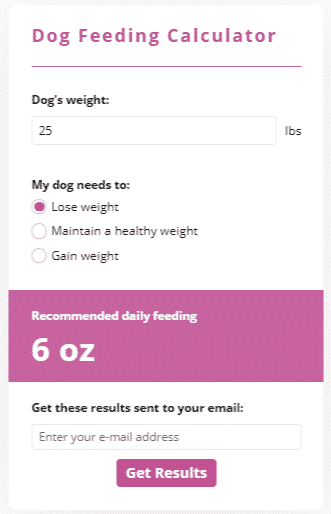
Some websites use tools and calculators to benefit the user but also push them to make a purchase or direct them to choosing the right product or service. Thirdlove is a brand that sells bras and helps women find their right size through a fun tool.

Even a company as big as Procter & Gamble understands the value of a tool in driving traffic to their brand’s website: Always. Always has a menstruation calculator that helps women keep track of their cycle easily. Tools and calculators are becoming a form of content marketing that has a true and viral impact.
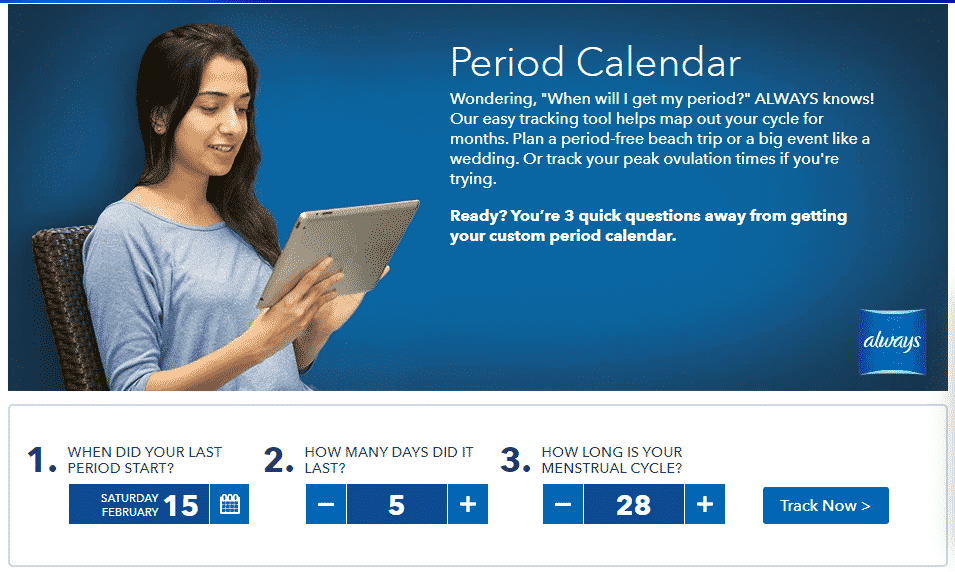
There are companies that offer easy and affordable tools and calculators that you can add as plugins to your website. Calconic and Codecanyon are two reliable companies that can help you with that. Calconic even offers one package for free and a variety of other packages ranging from six dollars per month to fifty-five dollars per month.
Fixing Your SEO Errors
Beside the content audit, you should also do a site audit using one of the SEO tools like UberSuggest. It will easily show you the areas of weakness that you can work on. Some of these SEO errors will be easy to fix like fixing broken links, avoiding duplicate Meta descriptions or titles.
Others may require you to do extra technical work like improving the speed of your website, especially on mobile devices. Moreover, UberSuggest will also help by telling you what the critical errors refer to and how you can fix them. Super helpful!
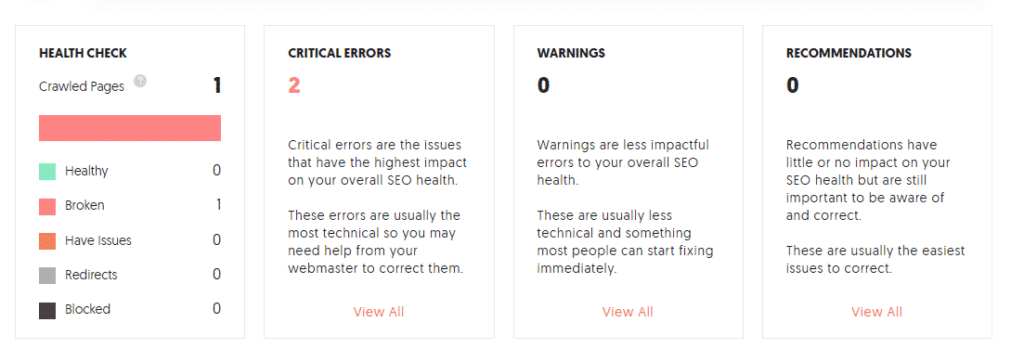
What Are the Skills You Need to Master SEO?
You don’t need to overcomplicate and overthink SEO. There are certain skills that would enable you to master SEO; especially if you’re aiming to become an SEO Specialist or rely on yourself to do your business’s SEO. This is a breakdown of your toolbox or the set of skills you need to dominate SEO.
Studying Search Results and Competitors
This is a central part of your SEO performance metrics analysis. The benefits of being up to date with what’s happening with search results and your competitors, at least on a weekly basis, are countless. Google and other search engines make frequent changes to their algorithms which affects the ranking and the results. That’s why you continuously need to be aware of what’s happening.
When it comes to your competitors, in order to be ahead of the game, you need to keep up with what the other players are doing. There are questions that you should always have the answers to.
Who’s ranking? How many backlinks do they have? What kind of backlinks? Where are they getting these backlinks from? Can you do the same? What kind of pages are ranking: e-commerce, content pages, or service pages? Or, is it an app? All this information you would need to incorporate into your SEO strategy if you want to rank.
In addition, you will gain a lot of insight on trending topics and what people are interested in. That way, you’ll never run out of fresh content ideas. Keeping an eye on the search engine and your competitors is an essential skill.
Keyword Planning and Strategising
Keyword planning is of major importance to improving your SEO performance. It’s not possible to succeed at SEO while being random or creating content on the spot.For most medium-sized and small businesses, your keyword strategy should be targeting keywords which have a higher potential of ranking.
But how can you select these keywords? UberSuggest and similar tools used for keyword analysis, like SEMrush or Keywords Everywhere, can help you. Whenever you search for a keyword using these tools, four important numbers would show up beside every keyword. These numbers refer to search volume, cost per click, paid difficulty, and SEO difficulty.
Search volume is the number of people searching for this keyword per month. Cost per click, pretty straightforward, average cost per click if you wanted to pay Google to be seen as an ad.
A keyword having a high CPC indicates that it’s valuable and drives conversion that businesses are willing to invest in it. Next is PD, or paid difficulty. This is a score that refers to estimated competition in paid search; the higher the number, the more competitive. Finally, SD, or SEO difficulty is the score indicating the estimated competition but in organic search.
What are the keywords that you can win at VS the ones that will be a waste of time? Search volume isn’t everything. Just because a word has a high search volume doesn’t mean that it’s going to lead to conversions. For example, if it’s Wikipedia you’re going after, Wikipedia has a high domain score.
Chances are, you’re not going to rank for keywords that they’re ranking for. You want to go after keywords that are less competitive. So, before choosing a target keyword, you need to look at what competitors are ranking for and see whether or not you can replicate this kind of metrics. Less competitive keywords are those which have an SEO difficulty score less than 40.
Going after less competitive keywords still gets you some traffic that has a high chance of converting, and you can still generate revenue. Once your business gets bigger and bigger and as you gain more authority, then you can start going after more competitive terms.
Types of Keywords That You Can Target
Understanding the search engine behaviour behind your target keywords is essential. Generally speaking, when someone is searching for any given keyword, their search falls into one of the following categories.
- The first category is navigational search. People use navigational keywords when they’re looking for a specific website that they already know. In this type of search, you’ll often see a brand name or a name of a product; like ‘YouTube’ ‘Samsung’ or ‘Profile Tree’. Google shows special snippets in the search results for navigational searches: site links, tweet box, or knowledge panel.



The next type of keywords is transactional. People using transactional keywords when they want to buy something. They’re ready to buy the product they’re looking for. Transactional keywords are those that include similar words like ‘buy’ ‘price’ ‘pricing’ ‘cheap’, etc. For example, ‘cheap Samsung laptop’ or ‘buy iPhone’. For transactional keywords, Google typically shows you snippets that follow paid ads or Google shopping results.

Another type of keywords is informational ones. People use these keywords when they’re seeking information for any given topic. It could be as simple as ‘how to feed a dog?’ or as complex as ‘how do spaceships work?’ When you study informational keywords, you’ll often find WH question words like: ‘who’ ‘where’ ‘why’ ‘what’ or words like ‘tutorial’ or ‘guide’. In case of informational keywords, Google shows featured snippets, knowledge card, videos, and people also ask snippet.

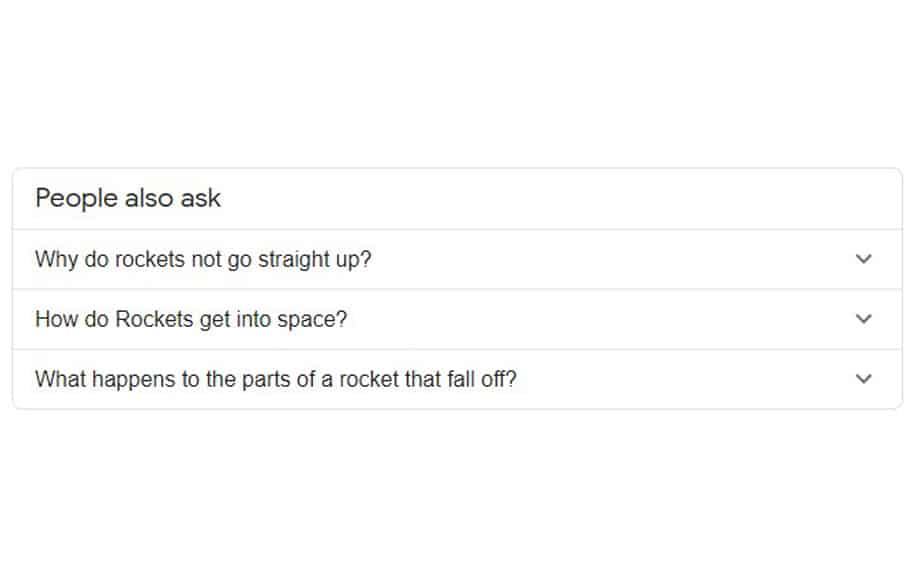
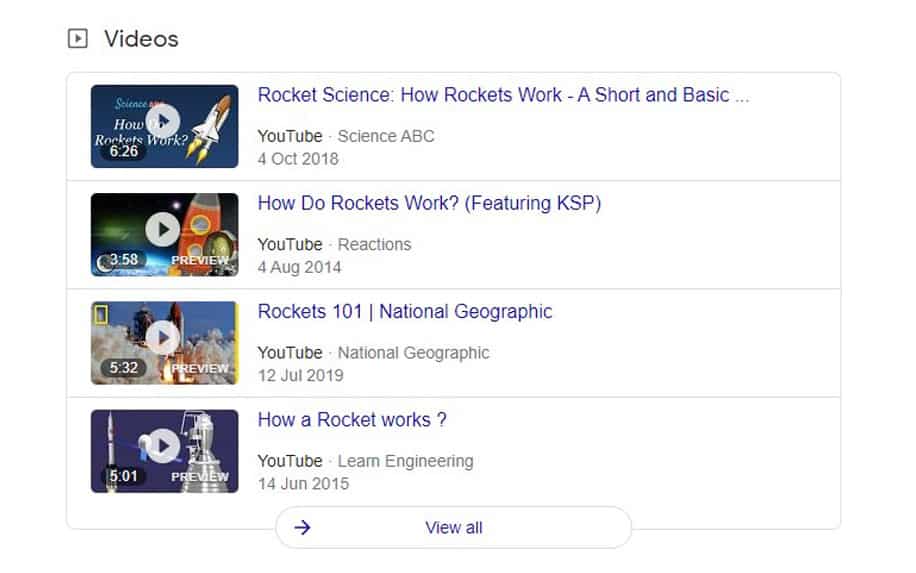
Typically, when you’re trying to get sales, you go after keywords with high conversion potential. Therefore, you want to chase informational or transactional keywords. Those two keywords can generate sales. While transactional can generate sales faster, informational ones won’t be as quick. However, informational keywords will also build a long term trust between your business and potential buyers.
Writing
SEO is all about delivering what people need and doing a better job than everyone else. Therefore, writing content is crucial if you want to master SEO, even if you’re outsourcing it. If you’re not good at writing, you can use your phone to record yourself and then use transcription services such as Rev.
You can also hire freelance writers from ProBlogger that can create SEO friendly articles and posts. You can use their content, make some amends to it according to your preferences, and then publish it on your website.
Research
Before writing each piece of content, you need to do thorough research and curation. In your content, you want to add data that nobody else is adding. Statistics, for instance, are a great thing that differentiates your content. Statista.com is a great place where you can find reliable data and numbers.
There’s also IBIS World and HelgiLibrary. Another thing that you could do is talk about academic papers. So, anytime you can find academic papers relevant to the topic you’re writing about, make sure you mention this information; cite your sources and link out to them.
Basic HTML
A skill that many don’t find necessary. However, it definitely differentiates you as an SEO specialist to know basic HTML. You’ll need this to edit title tags, meta-tags, or add an FAQ schema mark-up. These are essential hacks to get you higher rankings. HTML allows you to figure out how to structure your site’s hierarchy. You’ll have parent topics, sub-topics that you’ll need to arrange. If you don’t know basic HTML, you’ll have to hire a developer to do that work for you.
There are also some alternative plugins that can do some of these hacks for you without having to learn a line of code. If you’re using WordPress, you can use Yoast or RankMath plugins. These tools allow you to optimise your blog and adjust a lot of these HTML stuff easily with a few clicks of a button.
Analytics
This is mainly the topic of this article. Analytics is the skill of reading your SEO data and evaluating your performance. Your results will only be as good as your ability to measure them.
Gathering analytics and reading through data will make you understand where your users are spending their time, what kind of content to produce, what causes your visitors to bounce and what causes them to stay longer. Without this knowledge, you won’t be able to move forward.
Every move or decision that your visitor makes on your website matters. It’s important to measure the effectiveness of your content, why people are coming to your site, what visitors do once they land on the site and even the devices that they’re using.
You can only achieve that through analytics. SEO is about providing the best user experience, and you can’t offer the best user experience without knowing your user like the back of your hand.
Cold Outreach
Using any SEO analysis tool, you can easily find a direct correlation between the number of backlinks and having a high ranking. One of the most efficient and common ways to get backlinks is through reaching out to relevant websites or bloggers that could link to your content. When you’re starting out, each and every new backlink counts – that’s why you want to make the most out of your cold outreach.
It’s important to master cold outreach, whether by emailing, social media or even phone calls. You need to study how you can make a stranger interested and get them to link to you.
How you can craft an introduction that would make you seem likeable and approachable that people would want to talk to you. How to craft an amazing subject line that would get recipients hooked and how to persuade other people to take action.
If you’re trying to get backlinks hassle-free, you can use a tool such as Mailshake. They offer a lot of templates that they’ve tested and tried when it comes to link building. They even have a community support centre where you can live chat with people and they help you craft your own outbound emails to generate links. There are different tools that do a similar job like NinjaOutreach and BuzzStream.
More on Improving SEO Performance Metrics
We’ve probably stressed enough the importance of backlinks to building your website’s authority and ranking higher. We’ve also discussed different strategies to get more backlinks.
However, a lot of people are reluctant to build backlinks. They get scared because you would need to do outreach to hundreds, if not thousands, of website owners before you get your first handful of backlinks. Luckily, some of the hacks discussed earlier work as organic ways to get backlinks without having to do cold outreach.
One of these important hacks is having a free tool on your website. Tools are amazing at getting you traffic as well as backlinks. It won’t happen overnight, but as you gain more popularity, more people would use your tool and link to it.
Free Courses and Interactive Webinars
Another great hack is offering free courses or webinars. You probably know that everyone has a blog these days, and it’s really difficult to cut through the clutter. By going an extra mile and compiling an informative course or conducting an interactive webinar, you’re differentiating yourself and offering value to your visitors. That’ll keep them coming back and they would link out to your course as a source of information.
As you can see, Hubspot’s Academy which offers courses and training, for instance, has over 125 thousand backlinks.

Regardless of the industry you’re working in, you do have some exclusive insights and knowledge that you can share with those who care. The quality of the course material makes a whole lot of difference. Be sure that the effort you put into designing an intensive course that truly benefits its audience is going to pay off.
Statistics and Exclusive Industry Insights
Numbers are often overwhelming evidence in any business context. With everything now being data-driven, people love to back up their presentations, recommendations and speeches with numbers.
Of course, they would need to cite the sources of this information. That’s why posting statistics, studies, info-graphics, or industry insights is guaranteed to generate traffic and backlinks.
The businesses that do great at practising this hack are those that offer data analysis tools, like Kissmetrics, Crowd Analyzer, BrandWatch and many others. They usually release great reports at the end of each year. They could be great inspiration for you to create similar content to generate backlinks.
Great Infographics and Data Visualisation
Infographics are huge. Although they were even more powerful in the past, they’re still super effective. Combining statistics with animated interactive data visualisation is a tremendous combination.
Not only that people love numbers and data, they also love to digest this data in an easy and fun way. Furthermore, infographics are flexible, so don’t limit yourself to numbers.
Through info-graphics, you can showcase historical timelines, maps, distribution cycles, and plans. More importantly, you can tell stories and answer questions through info-graphics. That means that you can answer questions such as how car engines work or different animal species through animated infographics. Take a look at these amazing infographics examples.
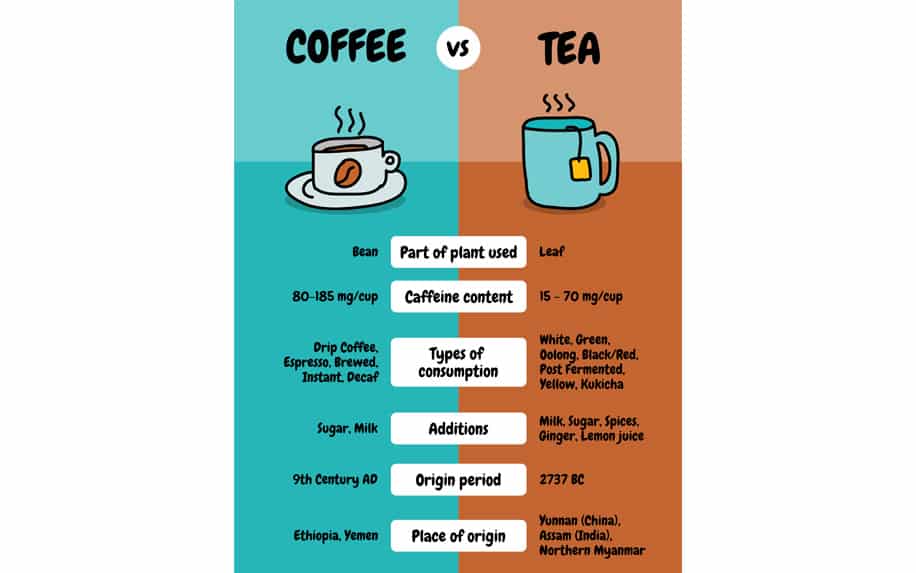



How to Increase Time Spent on Page
Include videos and embed them inside your blog videos. This is an easy hack that you can apply in all your blog posts. If visitors watch a two-minute video while they are on the same page, it will increase the overall time spent on page. That will totally influence the way Google views your content. Visitors staying for a little longer will improve your ranking.
SEO Performance Metrics Bottom-Line
Hopefully, your website’s monthly SEO report will be much easier to read and/or prepare. You now understand what the most important SEO performance metrics are, how to measure them and what they actually refer to.
In addition, you have a set of tools that should help you analyse and improve your SEO performance metrics. You’ve also understood some SEO hacks that will improve your SEO performance metrics including backlinks, time spent on page, your content writing.
Local SEO Metrics: Attracting Customers in Your Backyard
When your business targets customers in a specific geographic area, local SEO metrics become your compass for navigating the online landscape and attracting nearby leads. These metrics go beyond general SEO and dive into the nitty-gritty of online visibility within your local community. Let’s explore some key metrics to track and optimize for local SEO success:
1. Google My Business (GMB) Performance:
- Search Visibility: Does your GMB listing appear in the “Local Pack” (top 3 results) for relevant local searches? Track your ranking for target keywords.
- Click-Through Rate (CTR): How often do users click on your GMB listing in search results? Optimize your listing with compelling titles, descriptions, and images.
- Reviews and Ratings: Positive reviews and high ratings build trust and credibility. Encourage customers to leave reviews and respond promptly to both positive and negative feedback.
- Calls and Directions: Monitor how many calls and direction requests you receive through your GMB listing. This indicates direct engagement from local users.
- Website Clicks: Track how many users click through to your website from your GMB listing. Ensure your website is mobile-friendly and optimized for local keywords.
2. Local Keyword Rankings:
- Monitor rankings for targeted local keywords: Identify keywords relevant to your business and location, like “best [service] near me” or “[your city] [service].” Track your ranking for these keywords in local search results.
- Local Search Volume: Research search volume for local keywords using tools like Google Keyword Planner. Understand how often people search for these terms.
- Search Intent: Analyze the intent behind local searches. Users searching for “[your service] near me” are likely ready to convert, while those searching for “[your service] reviews” are in the research phase. Tailor your content and website experience accordingly.
3. Citations and Local Listings:
- Citation Consistency: Ensure your business name, address, and phone number (NAP) are consistent across all online directories and listings. Inconsistency can hurt your local SEO.
- Directory Coverage: Get listed on relevant local directories, such as Yelp, Bing Places, and industry-specific platforms. Each listing expands your local reach and provides backlinks.
- Reviews on Other Platforms: Track and encourage reviews on platforms beyond GMB, such as Facebook, TripAdvisor, and industry-specific review sites.
4. Mobile Friendliness and Page Speed:
- Mobile-first approach: Ensure your website is mobile-friendly, as most local searches happen on mobile devices. Google prioritizes mobile-friendly websites in local search results.
- Fast page load times: Optimize your website for speed. Slow loading times can frustrate users and hurt your local SEO ranking.
5. Local Content and Engagement:
- Create local content: Blog about local events, news, and topics relevant to your community. Use local keywords naturally in your content.
- Engage with local businesses and communities: Build relationships with other local businesses and participate in online communities. This can generate backlinks and boost brand awareness.
Remember: Local SEO is an ongoing process. Regularly monitor your metrics, analyze your results, and adjust your strategy accordingly. By focusing on these key metrics, you can attract more customers in your local area and establish your business as a trusted neighborhood resource.
E-commerce SEO Metrics: Measuring the Engines of Online Sales
In the bustling marketplace of e-commerce, SEO isn’t just about visibility – it’s about fueling success. That’s where E-commerce SEO metrics come in, acting as your dashboard for navigating the path to increased cart-filling and checkout clicks. Let’s delve into some crucial metrics to track and optimize for sustainable e-commerce SEO victory:
1. Organic Traffic and Keyword Performance:
- Organic Traffic Volume: How many visitors land on your product pages and other relevant pages through organic search? Monitor traffic trends and identify top-performing keywords.
- Keyword Rankings: Track your rankings for targeted keywords related to your products and services. Focus on optimizing product titles, descriptions, and category pages for relevant keywords.
- Bounce Rate: Analyze the bounce rate for your product pages. A high bounce rate (users leaving quickly) could indicate poor keyword targeting or irrelevant content.
2. Product Page Optimization:
- Product Page Views: See how many visitors view individual product pages. Understand which products draw the most interest and investigate those with low views.
- Time Spent on Product Pages: Track the average time users spend on product pages. Longer engagement time often indicates strong product information and compelling content.
- Click-Through Rate (CTR) on Call to Actions (CTAs): Monitor how often users click “Add to Cart” or “Buy Now” buttons on product pages. Optimize CTAs and surrounding content for clarity and persuasion.
3. Conversion and Revenue Metrics:
- Conversion Rate: Track the percentage of website visitors who complete a purchase. Analyze conversion funnels to identify drop-off points and potential friction areas.
- Average Order Value (AOV): Understand the average amount spent per order. Explore upselling and cross-selling opportunities to increase AOV.
- Customer Acquisition Cost (CAC): Compare your organic SEO ROI to other marketing channels to determine the cost-effectiveness of your SEO efforts.
4. User Engagement and Customer Experience:
- Product Reviews and Ratings: Encourage customer reviews and ratings, as positive feedback builds trust and influences purchase decisions.
- Website Search Usage: Analyze internal search terms to understand customer needs and identify keyword gaps for product descriptions and category pages.
- Wishlist and Cart Abandonment: Track abandoned carts and wishlists to understand friction points in the purchase journey and optimize the checkout process.
5. Technical SEO and Core Web Vitals:
- Website Speed: Ensure your website loads quickly on all devices, as slow loading times can lead to abandonment and hurt SEO performance.
- Mobile-Friendliness: Prioritize mobile responsiveness to deliver a seamless shopping experience for mobile users.
- Core Web Vitals: Monitor Core Web Vitals metrics like Largest Contentful Paint (LCP), First Input Delay (FID), and Cumulative Layout Shift (CLS) to ensure a smooth and stable user experience.
Remember: E-commerce SEO is a data-driven process. Regularly analyze your metrics, identify areas for improvement, and implement optimization strategies. By focusing on these key metrics and constantly tweaking your approach, you can turn your e-commerce website into a well-oiled machine, churning out happy customers and overflowing orders.
FAQ
Q: What are the most important SEO performance metrics for beginners?
A: For beginners, focus on core metrics like organic traffic, keyword rankings, bounce rate, and website speed. These will give you a good starting point for understanding your website’s SEO performance.
Q: How often should I track my SEO performance metrics?
A: Track your metrics regularly, at least once a month, to identify trends and adjust your strategy. You can also track specific metrics more frequently, like keyword rankings after making website changes.
Q: What tools can I use to track my SEO performance metrics?
A: Many free and paid tools can help you track your SEO performance, such as Google Search Console, Google Analytics, Moz, Ahrefs, and Semrush.
Q: I’m not seeing any improvement in my SEO performance. What should I do?
A: SEO is a long-term strategy, so don’t expect to see overnight results. If you’re not seeing improvement, analyze your metrics carefully to identify areas for improvement, such as keyword targeting, content optimization, or technical SEO issues.
Q: I’m a local business. What are some specific SEO metrics I should track?
A: For local businesses, track metrics like Google My Business performance, local keyword rankings, citations, and mobile-friendliness. These will help you improve your local search visibility and attract customers in your area.
Q: I run an e-commerce website. What SEO metrics are most important for me?
A: For e-commerce websites, focus on metrics like organic traffic, product page views, conversion rate, average order value, and website speed. These will help you optimize your website for organic traffic, product discovery, and purchase conversions.
Conclusion
Understanding and tracking SEO performance metrics is crucial for any website owner who wants to attract more visitors and achieve their online goals. By focusing on the right metrics and implementing proactive strategies, you can optimize your website for search engines and unlock the full potential of your online presence.
Remember, SEO is a continuous journey, so stay informed, track your progress, and adapt your strategies to stay ahead of the curve and achieve sustainable SEO success.


